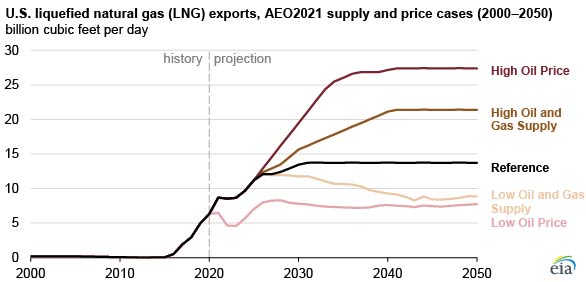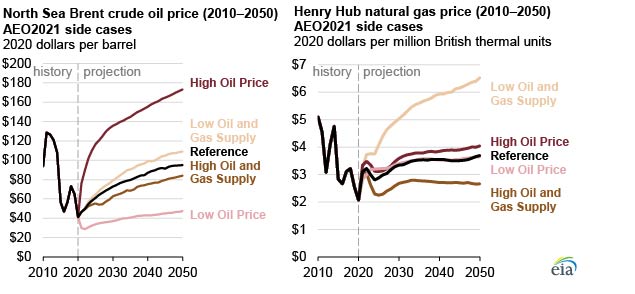The U.S. Energy Information Administration's (EIA) Annual Energy Outlook 2021 (AEO2021) projects that the volume of U.S. liquefied natural gas (LNG) exports through 2050 will span a wide range based on its published side cases. In the AEO2021 Reference case, U.S. LNG exports continue to grow throughout the 2020s, reaching 13.7 billion cubic feet per day (Bcf/d) after 2030. LNG exports vary across cases from approximately 8 Bcf/d to more than 27 Bcf/d, which illustrates how the volume of LNG exports depends on crude oil and domestic natural gas prices.

How the U.S. price for LNG compares with world LNG prices (which reflects the competitiveness of U.S. LNG exports in the global market) influences whether new liquefaction capacity is built and how EIA projects U.S. LNG export volumes. EIA used its Natural Gas Market Module (NGMM) to project how U.S. LNG supply prices compare with world markets using domestic natural gas prices and assumptions related to costs and fuel use to develop its AEO2021. To determine their competitiveness, NGMM compares these prices with world LNG prices for markets in both Europe and Asia, based on the following inputs:
The difference in projected U.S. LNG exports in the AEO2021 High and Low Oil Price cases reflects the relationship of world oil prices to U.S. liquefaction capacity builds and utilization rates. In the High Oil Price case, where the Brent crude oil price grows to almost $180 per barrel (b) in real terms by 2050, U.S. LNG exports exceed 27 Bcf/d by the end of the projection period. However, in the Low Oil Price case, where oil prices remain lower than $50/b in real terms during the projection period, U.S. LNG exports do not exceed 8 Bcf/d after 2030 because U.S. liquefaction capacity is underutilized. As a result of low oil prices, no new LNG export capacity is built beyond what is already under construction and expected to enter service by late 2025.
- World oil prices
- Relative growth of natural gas consumption in markets in Europe and Asia
- Relative growth of LNG supply not sold under long-term contracts, or flexible LNG supply

In the High Oil and Gas Supply case, where Henry Hub natural gas prices remain lower than $3.00 per million British thermal units (MMBtu) in real terms, U.S. LNG export volumes continue to grow through 2040, reaching a high of 21.4 Bcf/d in 2050. The Low Oil and Gas Supply case generates higher domestic natural gas prices, which reduces the global competitiveness of U.S. LNG exports. As U.S. Henry Hub prices rise from $5.00/MMBtu in 2030 to almost $6.50/MMBtu in 2050 in real terms, U.S. LNG export volumes decline to less than 9.0 Bcf/d by 2050, and existing liquefaction capacity becomes increasingly underutilized.


Follow us on social media: